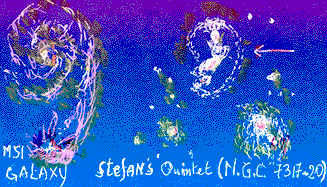Chapter 4 - Wave Theory and
the Atom
Printer-Friendly Version
Everything is formed from energetic matter by wave creation.
Galaxies at certain phases create atoms.
The behaviour of our universe after the Big Bang was a swirling,
inflationary movement, dispersing energy (see the chapter
on the universe). The largest formations eventually break
down into smaller wave-atoms. To explain the basic rules of
atomic structure, I will proceed from the smallest to the
largest formations. The creation of the same object occurs
in different ways, so that the same type of atom may appear
as an isotope.
Atoms with the highest atomic numbers are unstable and break
down easily into smaller waves. The exception to the rule
is hydrogen. Its atom-waves lose energy and join together.
This fusion reaction results in a stable helium atom with
an alpha structure. This structure plays a significant role
in the formation of atoms with higher atomic numbers.
We know that atoms are composed of protons and neutrons,
and that these primary structures are composed of sub-atomic
formations, like those we call quarks.
In astronomical observations, we see different formations
and behaviours of energetic matter. I think the best models
of atomic structure are the Whirlpool Galaxy, M51 and the
Stefan’s Quintet (N.G.C. 7137-20) galaxies (picture
below).

Loss of energy causes phase transitions. The main rules of
energetic behaviour are the same for all phases. Photographs
obtained from space show the actual behaviour of energetic
matter in different stages.
Back to
Top
Dr. Chaim Tejman, Copyright©
2001. All rights reserved.
[Index]
[Introduction]
[Summary] [Wave
Formation] [Photons] [Gravitation]
[Time]
[Atoms] [Life]
[Cancer] [Fundamental
Force] [Gender/Why Sex?]
[Sexual Reproduction]
[Schrodinger & Heisenberg]
[Creation] [Supernova]
[Dark
Matter & Astronomy] [Speed
of Light] [Cloud Formations]
[Natural Disasters] [Global
Warming] [Thermodynamics]
[Backward Time] [Quantum
Mechanics] [Compton Effect]
[Equations] [Predictions]
[Academic Correspondences] [Contact]
[Links] [Mysteries] |